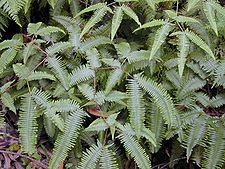- Gleicheniaceae
-
?Gleicheniaceae
Clasificación científica Reino: Plantae Clados superiores: Plantae (clado) Viridiplantae
Streptophyta
Streptophytina
Embryophyta
Tracheophyta
Euphyllophyta
MonilophytaClase: Polypodiopsida Orden: Gleicheniales Familia: Gleicheniaceae genera - Dicranopteris
- Diplopterygium
- Gleichenella
- Gleichenia
- Sticherus
- Stromatopteris
Contenido
Ubicación taxonómica
Plantae (clado), Viridiplantae, Streptophyta, Streptophytina, Embryophyta, Tracheophyta, Euphyllophyta, Monilophyta, Clase Polypodiopsida, Orden Gleicheniales, familia Gleicheniaceae.
Hennipman (1996) sugirió la inclusión de Dipteridaceae y Matoniaceae en Gleicheniaceae. Sin embargo Smith et al. (2006) mantienen a las familias divididas, debido a sus diferencias morfológicas distintivas.
Clasificación sensu Smith et al. 2006
6 géneros:
- Dicranopteris
- Diplopterygium
- Gleichenella
- Gleichenia
- Sticherus
- Stromatopteris
Cerca de 125 especies.
Filogenia
Monofilético (Hasebe et al. 1995, Pryer et al. 1995, 2001a y 2004b).
Ecología y Evolución
El registro fósil comienza en el Cretácico. Hay fósiles del Jurásico y también más antiguos, que pueden pertenecer a los Gleicheniales o representar ancestros de Gleicheniáceas extintas.
Pantropicales.
Caracteres
 Figura 2. Diagrama esquemático del ciclo de vida de las plantas vasculares sin semilla.
Figura 2. Diagrama esquemático del ciclo de vida de las plantas vasculares sin semilla.
Referencias:
n : generación haploide,
2n : generación diploide,
m! : mitosis,
M! : meiosis,
F! : fecundaciónLas gleicheniáceas son plantas vasculares con ciclo de vida haplodiplonte donde la alternancia de generaciones es bien manifiesta, con esporofito y gametofito multicelulares e independientes, con esporas como unidad de dispersión y de resistencia. El gametofito es un "talo" (cuerpo sin organización), y el esporofito es un "cormo" (con raíz, vástago y sistema vascular). Debido a estas características tradicionalmente se las agrupa con las "pteridofitas".
Poseen esporofitos con megafilos o "frondes" (Euphyllophyta).
Rizomas con una protostela "revitalizada", o raramente una solenostela.
Hojas de crecimiento indeterminado, láminas divididas pseododicotómicamente (excepto Stromatopteris). Venación libre, soros abaxiales, nunca marginales. 5 a 15 esporangios por soro. Esporangios redondos, sin indusio, con un anillo transversal-oblicuo. Esporangios madurando simultáneamente dentro de los soros. 128-800 esporas por soro.
Esporas globosas-tetraédricas o bilaterales.
Gametofitos verdes, superficiales, con pelos con forma de garrote.
Número de cromosomas: x = 22, 34, 39, 43, 56.
Véase también
- Clasificación de los organismos vegetales.
- Para ver una lista completa de los taxones ver Sistema de clasificación de monilophytas de Smith 2006.
- Para una descripción básica de morfología y anatomía de los helechos ver Pteridophyta.
Enlaces externos
- Stevens 2006, Angiosperm Phylogeny Website
- Pryer's lab con los pdfs de las publicaciones de la autora.
Otros proyectos wikimedia
 Wikimedia Commons alberga contenido multimedia sobre Gleicheniaceae. Commons
Wikimedia Commons alberga contenido multimedia sobre Gleicheniaceae. Commons Wikiespecies tiene un artículo sobre Gleicheniaceae. Wikispecies
Wikiespecies tiene un artículo sobre Gleicheniaceae. Wikispecies
Referencias
- Pryer, Kathleen M., Harald Schneider, Alan R. Smith, Raymond Cranfill, Paul G. Wolf, Jeffrey S. Hunt y Sedonia D. Sipes. 2001. "Horsetails and ferns are a monophyletic group and the closest living relatives to seed plants". Nature 409: 618-622 (resumen en inglés aquí).
- Pryer, Kathleen M., Eric Schuettpelz, Paul G. Wolf, Harald Schneider, Alan R. Smith y Raymond Cranfill. 2004. "Phylogeny and evolution of ferns (monilophytes) with a focus on the early leptosporangiate divergences". American Journal of Botany 91:1582-1598 (resumen en inglés aquí).
- A. R. Smith, K. M. Pryer, E. Schuettpelz, P. Korall, H. Schneider, P. G. Wolf. 2006. "A classification for extant ferns". Taxon 55(3), 705-731 (pdf aquí)
Wikimedia foundation. 2010.

